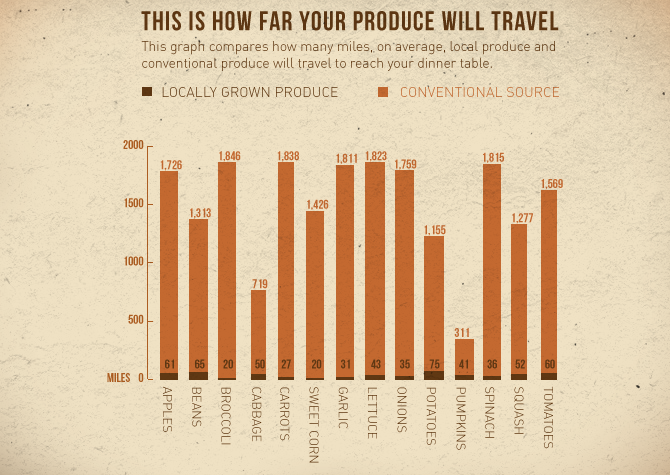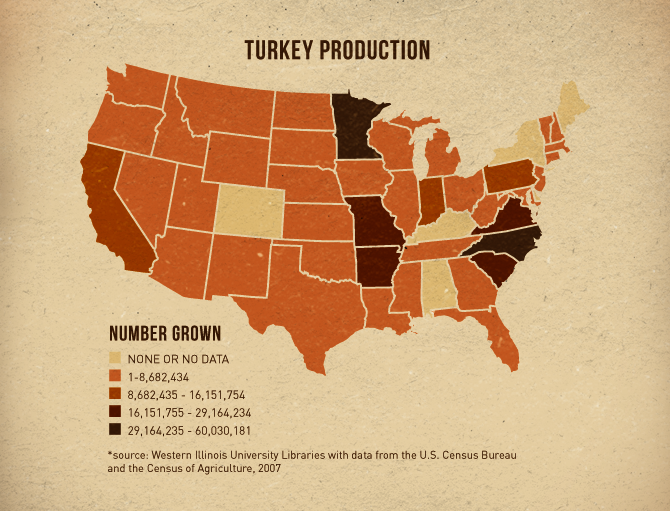In the spirit of using less fuel and supporting local farms and food artisans, we challenge you to try a 100-mile Thanksgiving. A 100-mile Thanksgiving uses ingredients sourced from within 100 miles of your dinner table. Think of it as an opportunity to celebrate local food, rather than an obligation to source every last ingredient from within 100 miles. Food miles, or the amount of miles a certain product has traveled to its final destination, are an important consideration when trying to reduce your carbon footprint and the amount of oil and gasoline used in making a meal.

This Thanksgiving, you can source just a few staples like turkey and squash locally, or make one dish, like a salad, using mostly local, seasonal ingredients. It’s a fun way to teach children about where their food comes from, and a wonderful way to introduce your guests to the unique bounty that your area has to offer. Besides, fresh foods that haven’t been sitting on a truck or airplane all week taste better! It’s fun for the chef too – there is nothing more festive than a farmers market the day before Thanksgiving, and it’s often less crowded than the local supermarket.
Shopping locally at Thanksgiving is actually pretty simple. After all, Thanksgiving is in essence our national seasonal feast. Even though every region and every family has its own signature Thanksgiving dishes, the staples of the meal – from pumpkins and cranberries, to sweet potatoes and brussels sprouts – are largely autumn seasonal foods.
The turkey is the one part of the meal where going local may require a bit more forethought, but it’s well worth it. There are many delicious alternatives to the conventional supermarket turkey that has often traveled far from its factory farm to your table.
Local Harvest is a great resource for finding any local ingredient. From heritage turkeys to local chickens, there are lots of ways to celebrate a tasty, local choice. Turkeys are grown in nearly every state!

You may say, “This is all very nice, but if I fly home for Thanksgiving, or drive 200 miles, doesn’t that negate the whole premise of the 100-Mile Thanksgiving?” Well, a long drive or flight certainly doesn’t decrease fuel usage, but every little bit counts. If you must fly home to see your family, why not avoid flying your food all over the place too! But if you’re open to it (and your family is amenable), there are ways to see your family and minimize the amount of gas you burn doing it!

-
Drive a fuel efficient car. Green Car Reports estimates that an average family traveling 100 miles by car (200 miles roundtrip) to reach their Thanksgiving celebration in a car capable of 26.4 mpg would spend twice as much on gasoline than if they made the same trip in a car capable of 54.5 mpg. If the trip had been made in an all-electric or plug-in electric car, the costs could have been measured in cents rather than dollars.
-
At the very least, maximize your fuel efficiency by making sure your tires are properly inflated, removing unneeded heavy items from your car, observing the speed limit, using cruise control, and practicing ecodriving techniques. These small changes actually do make a difference.
No matter where you live, or what your budget, there are ways to support farmers and reduce how much fuel you burn this Thanksgiving. Our 100-Mile Thanksgiving infographic below provides all kinds of tips for a more sustainable Thanksgiving from beginning to end! If you feel overwhelmed, remember that you can use as many or as few of these tips as you like. Sustainability is a practice and you can start small this Thanksgiving by making a local salad or trying some ecodriving techniques for your drive!

updated 11/2018
